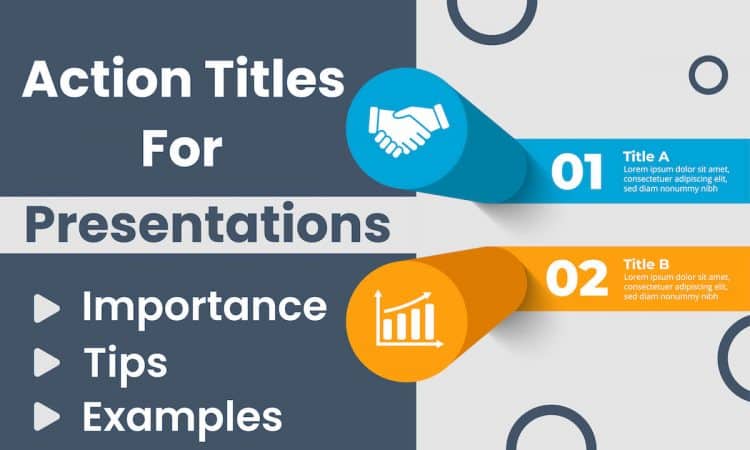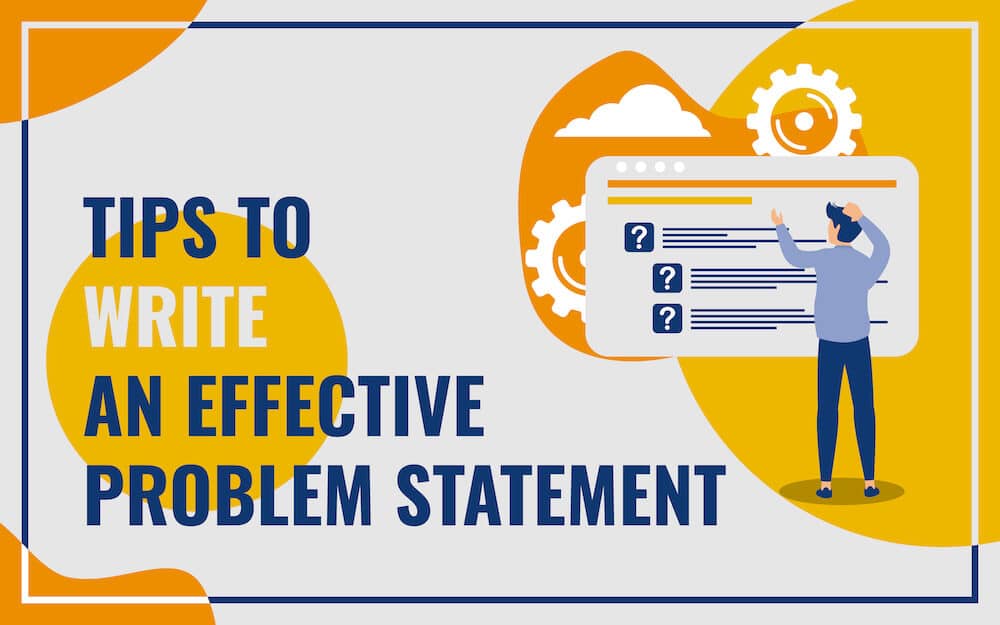A Detailed Guide to Write the Perfect Action Title for Your Next Presentation

Presentations are the modern method of communication. They are a dynamic source of information and are used in all fields, such as education, art, industry, aviation, business, etc. However, the success of a presentation depends on many factors such as the title of the presentation, the quality of content, presenter’s delivery, the effectiveness of the visuals and graphics, etc.
One of the most important aspects of creating effective slides is crafting compelling action titles. These titles act as signposts to take the audience through the presentation and provide them with a framework to understand the content. Well-crafted action titles can pique the audience’s curiosity and increase their attention spans.
In this article, we will take you through a detailed guide on how to craft the best action titles for your presentations. The article has been divided into the following sections-
2. Importance of Using Action Titles
3. Tips to Construct the Best Action Titles for Your Presentations
4. Real-Life Examples of Action Titles that Lead to Massive Success
What are Action Titles?
Before we dive into detail, let us understand what action titles are and how they are different from regular titles.
When it comes to presentations, titles play a crucial role in creating a hook to engage the audience. A good title is an active statement about your presentation and its content. It acts as a bridge between what the audience expects and what you are going to deliver.
For example, if your presentation is about Health and Wellness, you can craft your title as – “10 Lifestyle and Diet Changes for Better Health.” This title not only gives a brief about your slides, but also informs the audience about what they can expect throughout the presentation.
The Importance of Action Titles
The purpose of an action title is to provide a crisp summary of the content that follows. Action titles should be designed to create the audience’s interest in the topic. Let us understand the importance of such titles.
1. They Build Expectations
Action titles are one of the best ways to create anticipation and build the expectations of your audience. Right from the beginning of the presentation’s registration, you can use action titles to build excitement and create hype for your presentation. It will help you gain better audience turnover and provide a better experience for your viewers.
Thus, it is necessary to keep the titles clear, concise, and short to ensure that the audience understands the content completely. Using vague or abstract language can set wrong expectations and can lead to disappointments among the audience.
2. Action Titles Create Frameworks for the Audience
Action titles establish a link between different parts of the presentation, providing a sense of direction to the audience and creating a logical framework for them to follow along. It also makes it easier for them to understand the slides.
3. They Help Enhance Retention
Action titles that are memorable and relevant can enhance the audience’s retention of the content presented. When action titles are well-crafted, they can stick in the audience’s mind and help to reinforce the key takeaways from the presentation.
Therefore, it is important to avoid using passive voice in your titles.
Tips to Construct the Best Action Titles for Your Presentations
Now that we have understood the importance of great action titles, let us look at some tips on crafting them. We have listed eight such tips that will help you craft the most amazing action titles for your presentations.
1. Tailor the Title According to Your Audience
The first step in writing effective action titles is to understand your audience. You must know the core of your audience, which can be understood by answering the following questions-
- What are their interests?
- What is the background of your audience – are they beginners, amateurs, or experts?
- What are their problems, and how can your presentation solve them?
By understanding your audience, you can curate a title that would instantly captivate them and get them on their toes. It will also help them resonate more with your presentation.
For instance, if you are presenting to a group of top-level executives, you might want to use titles that aim at expanding businesses, establishing legacies, or focusing on generating more profits. However, if you are presenting to small business owners, you might want to use titles that focus on starting businesses, managing inventory, etc.
2. Use Active Language to Instigate Action
The purpose of action titles is to inspire action and increase audience engagement. This can be done by using verbs and phrases that communicate a sense of urgency and create a grave aura of the title.
Let us understand with the help of an example. Imagine that your company has created software for businesses that helps them manage and organize their inventory. Let us look at two titles and analyze which one sounds better-
- “Benefits of Our Inventory Management Software”
- “Revolutionize Your Inventory With Our Software in No Time”
The first title sounds plain, boring, and monotonous. However, the second title instantly ignites curiosity and pushes one to explore the software being discussed.
Thus, using active language makes your titles stand out and helps attract prospects and clients.
3. Keep the Titles Short and Simple
When it comes to titles, less is always more. Keeping your titles short and sweet will enable your audience to read, remember, and understand more about the presentation. Your titles can be anywhere between four to ten words.
For example, short titles such as “5 Tips to Create a Winning Investor Pitch” sounds much better than “5 Tips to Create a Pitch That Will Help You Win the Investment Round.”
4. Grab Attention With Numbers and Statistics
Statistics and numbers are powerful ways to reassure your audience about the value of your presentation. They can help your presentation look much more professional and organized and can increase your credibility as a presenter.
Let us understand with the help of an example- consider that you want to sign up for a presentation on increasing your business’s sales. You come across two presentation seminars with the following titles-
- “Increase Your Company’s Sale”
- “Increase Your Sales by 50% in Just 90 Days!”
Which title would captivate you more? Of course, the second one, because it denotes your expertise and experience in the given field. It also delivers a message of assurance to the viewers and gives them the confidence to sign up for the presentation.
5. Interact and Engage With Question Titles
Question titles are a great way to get your audience thinking about your presentation’s topic. By putting up a question before them, you can foster their curiosity and inspire them to learn and know more about the topic.
Let us understand this with an example- consider that you are delivering a presentation on Marketing to a group of business owners.
Instead of putting up your title as “Great Marketing Strategies for Your Business,” you can frame it as “What are Some Great Marketing Strategies to Elevate Your Business?”
This title not only conveys the theme of your presentation, but also encourages your audience to think about how your strategies can benefit their businesses.
6. Drive Sales by Communicating the Problem and Solution
Another effective way of closing deals and driving more sales is by highlighting the problems faced by your audience and putting emphasis on the solutions that you can provide for them. Such titles are usually beneficial for companies offering products, services, or consumables.
For example, imagine that you own a beauty brand and are launching a new product that solves the problem of acne and works on skin texture.
Now, instead of opting for a simple title like “Benefits of Our New Anti-Acne Gel,” you can write, “Heal Acne Scars and Skin Texture With Our Anti-Acne Gel.” This title addresses the pain point of the audience and provides them with an instant solution.
7. Organize Your Title in the Form of a Numbered List
Numbered lists or titles can allow you to break down complex topics into simpler ones. They can make your presentations more structured, organized, and easier to understand.
For instance, you can use the title “10 Ways to Improve Your Presentation Design” instead of writing “Ways to Improve Your Presentation Design.”
Adding a number will help your audience follow you along throughout the presentation.
8. Weave Stories Around Your Action Title
Story titles are one of the best ways to make your presentations more interactive, interesting, and amusing. Weaving stories in your titles can instantly hook their attention onto your slides for the rest of the presentation.
Let us understand with an example- imagine that you are supposed to give a presentation on how small businesses can increase their sales.
Instead of using a title that says, “Ways to Increase Sales for Your Small Business,” you can add a short story or anecdote in your presentation and reconstruct the title as “How One Small Business Owner Increased Her Sales by 80% in Just One Year.”
This title is absolutely awestruck and will immediately blow your audience’s minds.
Real-Life Examples of Action Titles That Lead to Massive Success
Let us have a look at some real-life examples of books, presentations, and campaigns that harnessed the power of action titles for their headings, which led to massive success for each one of them.
1. “How to Win Friends and Influence People” by Dale Carnegie
This title summarizes the essence of the book in seven words and inspires action immediately. The book was published in 1936 and still remains one of the best sellers in the field of self-help books. Its title instantly attracts the audience and makes them want to explore what is written on the pages of this book.
2. “The Seven Habits of Highly Effective People” by Stephen Covey
This numbered action title speaks of seven particular habits and straight away tells the readers about the framework of the book. This allows the audience to understand the promise of the book, that is, to teach the readers seven habits of highly effective people.
3. “The Ultimate Driving Machine” – BMW
This action title is short and well-defined. It is extremely memorable and throws light on the benefits of owning a BMW. It inspires action by promoting a sense of luxury and quality, making BMW one of the most successful luxury car companies in the world.
4. “Just Do It” – Nike
One of the shortest action titles of all time, “Just Do It” by Nike, has helped it conquer sales in most countries around the globe. This was possible as the title kept igniting people’s urge to move and get into the spirit of working out, playing sports, or getting athletic.
5. “Taste the Rainbow” – Skittles
Well, the title itself reflects the hues of the most loved candy of all time, Skittles. This action title reflects the brand’s value and stresses its unique value. It persuades people to try Skittles and feel what a rainbow would taste like!
Conclusion
Successful presentations are the ones that are inspirational, encouraging, and motivating. They not only persuade the audience to initiate action, but also show them a pathway of possibilities and opportunities. Thus, a well-put-up action title can help you get through your presentation successfully and can make you stand apart from the crowd!
We hope this article helps you craft mind-blowing action titles for your next presentations.





